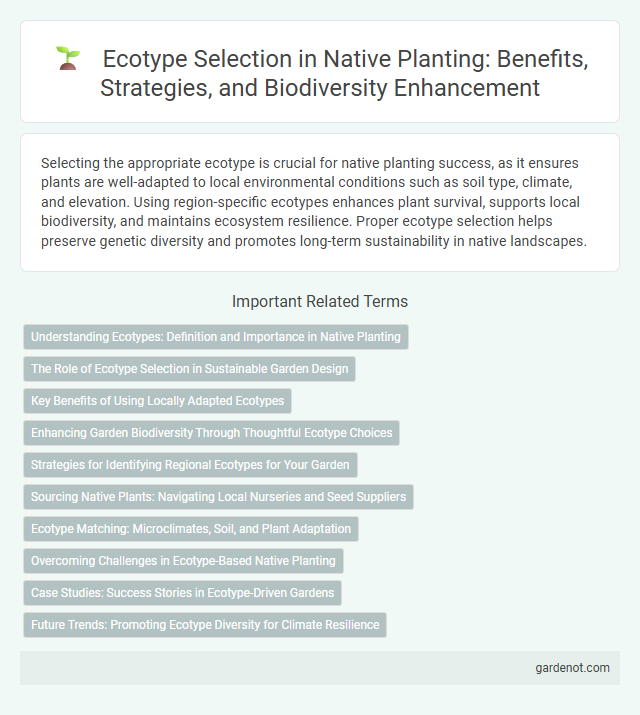Selecting the appropriate ecotype is crucial for native planting success, as it ensures plants are well-adapted to local environmental conditions such as soil type, climate, and elevation. Using region-specific ecotypes enhances plant survival, supports local biodiversity, and maintains ecosystem resilience. Proper ecotype selection helps preserve genetic diversity and promotes long-term sustainability in native landscapes.
Understanding Ecotypes: Definition and Importance in Native Planting
Ecotypes are genetically distinct populations within a species that have adapted to specific environmental conditions. Selecting appropriate ecotypes for native planting ensures plants are well-suited to local soil, climate, and ecological interactions, promoting greater survival and ecosystem stability. This approach enhances biodiversity by maintaining regional genetic diversity and supporting native wildlife habitats.
The Role of Ecotype Selection in Sustainable Garden Design
Ecotype selection plays a crucial role in sustainable garden design by ensuring plants are adapted to local environmental conditions, enhancing resilience and reducing maintenance needs. Utilizing native ecotypes supports biodiversity by preserving local genetic diversity and providing habitat for indigenous wildlife. Incorporating ecotype-specific plants improves water efficiency and soil health, promoting long-term ecological balance in garden ecosystems.
Key Benefits of Using Locally Adapted Ecotypes
Using locally adapted ecotypes in native planting enhances plant survival rates and resilience by matching genetic traits to specific regional environmental conditions. These ecotypes support local biodiversity by providing habitat for native wildlife and maintaining soil health through natural nutrient cycling. Additionally, choosing native ecotypes reduces the need for irrigation, fertilizers, and pesticides, promoting sustainable landscaping practices.
Enhancing Garden Biodiversity Through Thoughtful Ecotype Choices
Selecting native plant ecotypes tailored to local soil, climate, and ecosystem conditions significantly enhances garden biodiversity by supporting indigenous wildlife and promoting resilient plant communities. Choosing region-specific ecotypes ensures genetic diversity and adaptability, which strengthens ecosystem stability and fosters natural pest resistance. Incorporating a variety of these ecotypes enriches habitat complexity, benefiting pollinators, birds, and beneficial insects critical to a thriving, balanced garden environment.
Strategies for Identifying Regional Ecotypes for Your Garden
Selecting regional ecotypes for your garden involves analyzing local climate data, soil composition, and natural vegetation patterns to ensure plant adaptability and resilience. Collaborating with native plant societies and consulting regional seed banks can provide access to genetically appropriate stock that supports local biodiversity. Monitoring plant performance across microhabitats further refines ecotype selection, optimizing growth and ecological compatibility.
Sourcing Native Plants: Navigating Local Nurseries and Seed Suppliers
Sourcing native plants requires careful ecotype selection to ensure regional adaptation and ecosystem compatibility. Prioritize local nurseries and seed suppliers that specialize in native species with proven provenance within your target area, supporting genetic diversity and resilience. Verify plant origins and cultivation practices to enhance survival rates and ecosystem benefits in native planting projects.
Ecotype Matching: Microclimates, Soil, and Plant Adaptation
Ecotype selection in native planting emphasizes matching plant populations to specific microclimates and soil conditions to enhance adaptation and survival. Utilizing local ecotypes ensures plants are genetically suited to regional temperature fluctuations, moisture levels, and soil pH, promoting resilience against environmental stressors. This precision in plant adaptation supports biodiversity, improves ecosystem stability, and reduces the need for intensive maintenance.
Overcoming Challenges in Ecotype-Based Native Planting
Selecting the appropriate ecotype for native planting ensures optimal adaptation to local environmental conditions, enhancing plant survival and ecosystem health. Overcoming challenges in ecotype selection involves detailed soil analysis, climate compatibility assessments, and genetic diversity considerations to prevent maladaptation and promote resilience against pests and climate change. Employing regional seed sources and collaborating with ecological experts further supports successful restoration and conservation outcomes.
Case Studies: Success Stories in Ecotype-Driven Gardens
Case studies in ecotype-driven gardens demonstrate how selecting native plants from local ecotypes enhances garden resilience, biodiversity, and ecosystem services. Gardens using region-specific ecotypes show increased survival rates, reduced irrigation needs, and improved habitat support for pollinators and native wildlife. These success stories highlight the importance of matching plant provenance to local environmental conditions for sustainable native landscaping.
Future Trends: Promoting Ecotype Diversity for Climate Resilience
Future trends in native planting emphasize promoting ecotype diversity to enhance climate resilience by selecting plant varieties adapted to specific local conditions and projected environmental changes. Integrating genetic diversity within ecotypes supports ecosystem stability, improves drought tolerance, and enables species to better withstand temperature fluctuations and extreme weather events. This strategic approach guides restoration projects and landscaping efforts to create sustainable, adaptive landscapes responsive to evolving climates.
Ecotype selection Infographic

 gardenot.com
gardenot.com